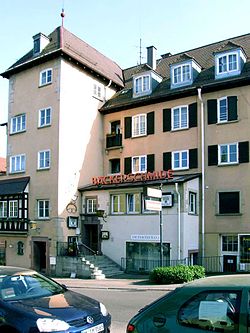food.wikisort.org - Dish
Gaisburger Marsch (German for "march of Gaisburg") is a traditional Swabian beef stew,[1] named after Gaisburg, a district of Stuttgart.
This article needs additional citations for verification. (April 2014) |
 | |
| Type | Stew |
|---|---|
| Place of origin | Germany |
| Region or state | Swabia |
| Main ingredients | Meat, beef broth, potatoes, Spätzle |

The meat, cooked in a strong beef broth, is cut into cubes and served with cooked potatoes and Spätzle. The broth is poured over the dish before topping with golden-brown onions fried in butter.
One explanation for the name Gaisburger Marsch is that the dish was so popular in the 19th century among officer candidates that they marched all the way to Gaisburg where their favorite dish was served in the restaurant called Bäckerschmide. Another version claims that locals from Gaisburg became prisoners of war and their women were only allowed to bring them one meal every day, so they created this nourishing dish and marched with it to the camp. The district of Gaisburg (today part Stuttgart Ost) hosts annual celebrations with a festival lasting several days.
Gaisburger Marsch is the favourite food of ex-Bundespräsident Horst Köhler, Wolfgang Schneiderhan and Chef Harald Wohlfahrt.
See also
- List of stews
References
- Peter Lesniczak: Alte Landschaftsküchen im Sog der Modernisierung. Studien zu einer Ernährungsgeographie Deutschlands zwischen 1860 und 1930, Teil 4. Franz Steiner Verlag, Stuttgart 2003, ISBN 3-515-08099-6, S. 173 (Studien zur Geschichte des Alltags; Bd. 21).
На других языках
- [en] Gaisburger Marsch
[ru] Гайсбургский марш
«Га́йсбургский марш» (нем. Gaisburger Marsch) — традиционное блюдо швабской кухни, айнтопф, особенностью которого является присутствие среди ингредиентов не только картофеля, но и макаронных изделий шпецле. Блюдо появилось в XIX веке в Штутгарте: местные офицеры маршевым порядком отправлялись обедать в трактир «Беккершмиде» в близлежащий городок Гайсбург, где подавали их любимый сытный и дешёвый суп[1][2]. По другой версии, жёнам военнопленных из Гайсбурга разрешалось приносить мужьям только одну миску еды в день, поэтому женщины собирали в такую передачу всё сразу и отправлялись в путь[3].Другой контент может иметь иную лицензию. Перед использованием материалов сайта WikiSort.org внимательно изучите правила лицензирования конкретных элементов наполнения сайта.
WikiSort.org - проект по пересортировке и дополнению контента Википедии